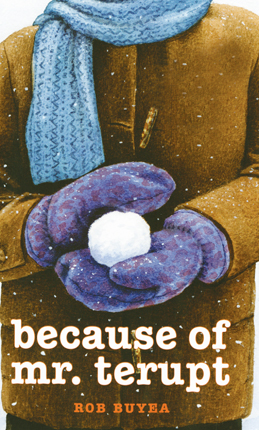| Because of Mr. Terupt (Mr. Terupt) Author: Buyea, Rob | ||
| Price: $23.08 | ||
Summary:
Seven fifth-graders at Snow Hill School in Connecticut relate how their lives are changed for the better by "rookie teacher" Mr. Terupt.![]() Download a Teacher's Guide
Download a Teacher's Guide
| Accelerated Reader Information: Interest Level: MG Reading Level: 3.70 Points: 5.0 Quiz: 140141 | Reading Counts Information: Interest Level: 3-5 Reading Level: 3.20 Points: 10.0 Quiz: 51692 | |
Common Core Standards
Grade 4 → Reading → RL Literature → 4.RL Key Ideas & Details
Grade 4 → Reading → RL Literature → 4.RL Craft & Structure
Grade 4 → Reading → RL Literature → 4.RL Integration & Knowledge of Ideas
Grade 4 → Reading → RL Literature → Texts Illustrating the Complexity, Quality, & Rang
Grade 6 → Reading → RL Literature → 6.RL Range of Reading & Level of Text Complexity
Grade 6 → Reading → CCR College & Career Readiness Anchor Standards fo
Grade 5 → Reading → RL Literature → 5.RL Range of Reading & Level of Text Complexity
Grade 6 → Reading → RL Literature → 6.RL Key Ideas & Details
Grade 6 → Reading → RL Literature → 6.RL Craft & Structure
Reviews:
Kirkus Reviews (09/15/10)
School Library Journal (+) (12/01/10)
Booklist (10/15/10)
The Bulletin of the Center for Children's Books (A) (12/10)
Full Text Reviews:
Booklist - 10/15/2010 Mr. Terupt follows in the footsteps of those inspiring teachers who encourage their students to think for themselves, question the conventions they understand about school, and become better people. The narration here is shared by so many that it is hard for readers to feel similarly inspired, but what they’ll get instead is the school-year-long unfolding of each of seven fifth-graders as they face their own flaws, come to terms with their home lives, and reconcile their roles in a tragic accident that nearly takes the life of their beloved teacher, hinted at with the innocuous-looking snowball on the front cover. Some voices ring less true than others, which is a shame, since all of the characters have something important to say. Despite its flaws, this is a compelling novel with brief—sometimes very brief—chapters, which keep the story moving. Readers will find much to ponder on the power of forgiveness in Buyea’s meditative first novel. - Copyright 2010 Booklist.
Bulletin for the Center... - 12/01/2010 Seven fifth-graders greet the new school year with trepidation, but they soon have their jitters put to rest by their new teacher, Mr. Terupt. With creative assignments and a jokey disciplinary style, he engages the kids individually, challenging the mathematically smart boy, playfully upbraiding the mischievous joker, paying attention to the quiet girl, etc. He even, finally, comes down hard on the mean girl, letting her know in no uncertain terms that her attempts to start girl wars among her classmates will no longer be tolerated. His greatest triumph comes when he has the students read Summer of the Swans and then spend time with the special needs kids; it is here where all of the children find their hearts. Then tragedy strikes when a forbidden snowball catches him in the head and cracks his sports-weakened skull, putting him in a coma. The children all feel responsible, but even while in a coma, Mr. Terupt continues to make a difference in their lives, breaking down communication barriers among their families and healing long-cherished grudges. Yes, this messianic teacher narrative is as schlocky and sentimental as it sound, but the structure works to mitigate some of the cavity-inducing sweetness. The children narrate the story in a quick, round-robin fashion, with distinctive voices that convey their personalities well. They are at times a bit too self-aware of their motives, and the mean girl’s voice is not at all credible; for the most part, though, young readers will appreciate the snapshot effect of the short segments, and most will find a character or two and with whom they can relate. The sentimentality will be affecting for younger readers as well, many of whom develop strong attachments to good teachers and will thus relate to the feelings these children express for theirs. KC - Copyright 2010 The Board of Trustees of the University of Illinois.
School Library Journal - 12/01/2010 Gr 4–6—Seven fifth graders at Snow Hill School in Vermont learn a variety of life lessons, not necessarily from their textbooks, when they start the school year off with their new teacher. Short chapters are actually brief narratives by individual students and sectioned off by each month of the school year, beginning with September. From the students' distinct voices readers come to understand the different personalities and backgrounds that define them. Peter, the prankster; Danielle, who never stands up for herself; and Jessica, the new girl in town who hides behind her favorite books, are just a few of the characters who shape readers' vision of the classroom. As their narrative continues, readers realize that each child has a story that only begins in school; it's the problems and conflicts that make up their home lives that come full circle because of a prank that results in tragedy. Mr. Terupt is that one teacher who really understands them, who always seems to be on their side, and who teaches them a valuable lesson no matter how much some of them try to shut him out. If the school year is a series of events, then Mr. Terupt is the catalyst that starts the chain reaction. The characters are authentic and the short chapters, some less than a page, are skillfully arranged to keep readers moving headlong toward the satisfying conclusion.—Cheryl Ashton, Amherst Public Library, OH - Copyright 2010 Publishers Weekly, Library Journal and/or School Library Journal used with permission.



